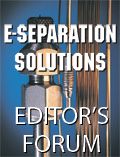IFPAC 2010 Preview
The Twenty-Fourth IFPAC Forum and Exhibition will be held at the Baltimore Marriott Waterfront January 31-February 4, 2010 (www.ifpac2010.org).
The Twenty-Fourth IFPAC Forum and Exhibition will be held at the Baltimore Marriott Waterfront January 31-February 4, 2010 (www.ifpac2010.org). The conference will cover critical and influential topics bringing academia, industry, and government together to share up-to-date knowledge and solutions.The intensive three-day program will feature a high-profile plenary covering challenges and sustainability impacting industry and business today, and will be followed by forward-looking tracks with over 20 sessions covering the latest trends and technology on innovative research and progress. Here are some highlights:
•The QbD track is back with new and cutting edge information.
•Presentations on innovative research and progress in areas such as design space, real time release, PAT & process control, pharmaceutical imaging, bio-processing, chemometrics, biotechnology, spectroscopy, nanotechnology, separations, and data management.
•New sessions on food safety and analysis, continuous processes, and modeling.
• Expert speakers, ground-breaking case studies, group discussions, and networking Receptions.
•A comprehensive exhibition of PAT equipment and services.
•Special workshops/training opportunities and expanded poster session.
Highlights of the technical program include:
Tuesday, February 2, 2010Tuesday AM
Plenary Session
A Stimulus for Product Quality and Lifecycles...Facing Today's ChallengesChairs: Theodora Kourti, George Vickers and Vincent L. Vilker
Tuesday PM
• QbD - I - New Directions & Modeling
• Bio-Processing (Industrial)
• Advanced Instrumental Concepts for Process Analysis
• Process Analysis/Spectroscopy - I
• Process Raman Symposium
• Chemometrics and Process Analytics - ITuesday-Evening: Session on QbD
This evening session will provide the opportunity for an extensive discussion on issues related to QbD.
Wednesday, February 3, 2010Wednesday AM
• QbD - II - PAT
• Food Safety - Microbiological Contaminants
• NeSSI-I
• Advanced Separations- I (MS/HPLC/Components/GC)
• Imaging: Data Analysis and Emerging Techniques
• Chemometrics and Process Analytics - II
Wednesday PM
• QbD - III - Applications
• Food Safety - Chemical Contaminants
• NeSSI-II
• Advanced Separations - II (Smart & microGC)
• Imaging for Quality & Process Understanding
• Life Cycle Management of Analyzer and Method Reliability
• Poster Session
• Special Session I: PAT Applied for Biologics ManufacturingWednesday Evening: Session on NeSSI
Thursday, February 4, 2010Thursday AM
• Continuous Processes
• Food Applications - PAT
• Process Understanding & Control
• Pharma Waters and Real-Time Analysis
• Screening and Surveillance Techniques using Handheld Instrumentation
• Analyzer Integration
• Shelter Safety
• Special Session – II: Data Communications and Data Management
Thursday PM
• QbD-IV-Knowledge Management and Continuous Improvement
• PAT/Pharma/Biotech
• Particle Characterization/Analysis-Ultrasound Spectroscopy
• Process Analysis/Spectroscopy - IIFor more information, contact 847-543-6800, info@ifpacnet.org or visit www.ifpac2010.org.
Determining Neurotransmitters in Spinal Cords with UHPLC
February 18th 2025Researchers at Jilin University (Changchun, China) developed a highly sensitive, rapid, and accurate method for analyzing neurotransmitters (NTs) in rat spinal cord tissue. Ultra-high performance liquid chromatography-triple quadrupole tandem mass spectrometry (UHPLC-QqQ-MS/MS) in conjunction with ultra-ionic liquid dispersive liquid-liquid microextraction (UA-MIL-DLLME) were used to extract NTs for analysis.
The Next Frontier for Mass Spectrometry: Maximizing Ion Utilization
January 20th 2025In this podcast, Daniel DeBord, CTO of MOBILion Systems, describes a new high resolution mass spectrometry approach that promises to increase speed and sensitivity in omics applications. MOBILion recently introduced the PAMAF mode of operation, which stands for parallel accumulation with mobility aligned fragmentation. It substantially increases the fraction of ions used for mass spectrometry analysis by replacing the functionality of the quadrupole with high resolution ion mobility. Listen to learn more about this exciting new development.
Revolutionizing LC-MS with Next-Gen Separation for Cyclic Peptide Analysis
February 17th 2025Cyclic peptides, known for their stability and high specificity, are promising therapeutic agents in the fight against cancer, infections, and autoimmune diseases. However, developing effective cyclic peptides presents numerous challenges, including poor pharmacokinetics, efficacy, and toxicity. Traditional methods like liquid chromatography tandem-mass spectrometry (LC-MS/MS) often struggle with resolving isomeric linear peptide metabolites, posing significant risks in safety, efficacy, and regulatory approval. In this paper, Komal Kedia, PhD, will share how she leveraged MOBIE’s high-resolution ion mobility-mass spectrometry (IM-MS) system to achieve a 72% reduction in run times, 200% greater resolving power, and enhanced accuracy in identifying “soft spots” prone to enzymatic degradation.














